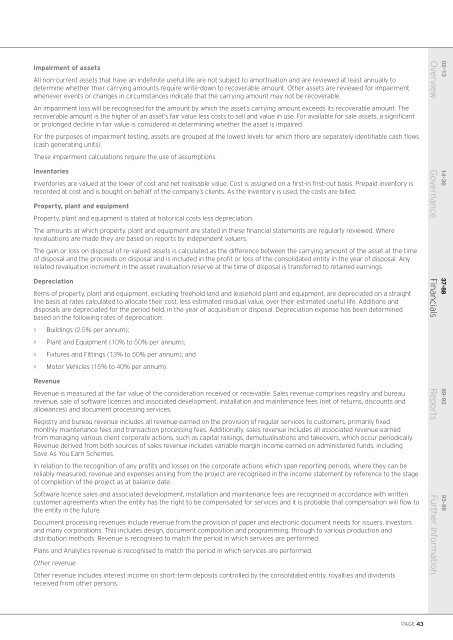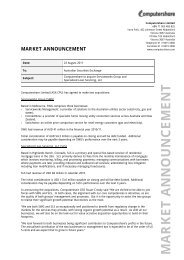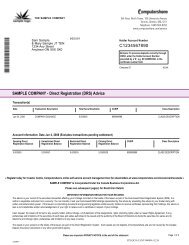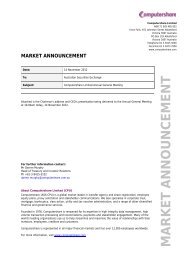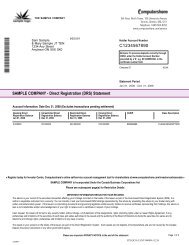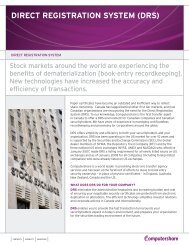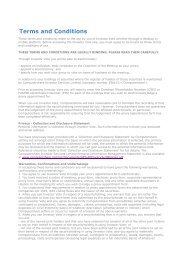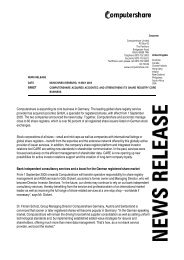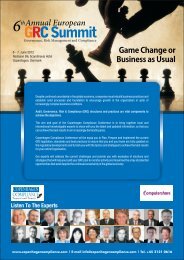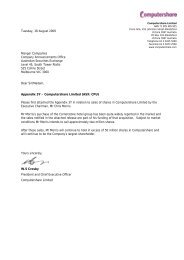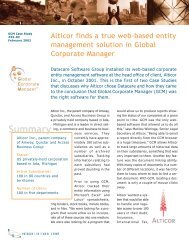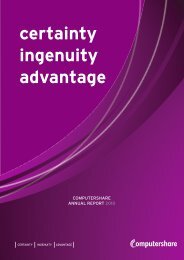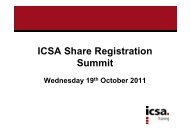COMPUTERSHARE ANNUAL REPORT 2008
COMPUTERSHARE ANNUAL REPORT 2008
COMPUTERSHARE ANNUAL REPORT 2008
Create successful ePaper yourself
Turn your PDF publications into a flip-book with our unique Google optimized e-Paper software.
Impairment of assetsAll non-current assets that have an indefinite useful life are not subject to amortisation and are reviewed at least annually todetermine whether their carrying amounts require write-down to recoverable amount. Other assets are reviewed for impairmentwhenever events or changes in circumstances indicate that the carrying amount may not be recoverable.An impairment loss will be recognised for the amount by which the asset’s carrying amount exceeds its recoverable amount. Therecoverable amount is the higher of an asset’s fair value less costs to sell and value in use. For available for sale assets, a significantor prolonged decline in fair value is considered in determining whether the asset is impaired.For the purposes of impairment testing, assets are grouped at the lowest levels for which there are separately identifiable cash flows(cash generating units).These impairment calculations require the use of assumptions.InventoriesInventories are valued at the lower of cost and net realisable value. Cost is assigned on a first-in first-out basis. Prepaid inventory isrecorded at cost and is bought on behalf of the company’s clients. As the inventory is used, the costs are billed.Property, plant and equipmentProperty, plant and equipment is stated at historical costs less depreciation.The amounts at which property, plant and equipment are stated in these financial statements are regularly reviewed. Whererevaluations are made they are based on reports by independent valuers.The gain or loss on disposal of re-valued assets is calculated as the difference between the carrying amount of the asset at the timeof disposal and the proceeds on disposal and is included in the profit or loss of the consolidated entity in the year of disposal. Anyrelated revaluation increment in the asset revaluation reserve at the time of disposal is transferred to retained earnings.DepreciationItems of property, plant and equipment, excluding freehold land and leasehold plant and equipment, are depreciated on a straightline basis at rates calculated to allocate their cost, less estimated residual value, over their estimated useful life. Additions anddisposals are depreciated for the period held, in the year of acquisition or disposal. Depreciation expense has been determinedbased on the following rates of depreciation:> Buildings (2.5% per annum);> Plant and Equipment (10% to 50% per annum);> Fixtures and Fittings (13% to 50% per annum); and> Motor Vehicles (15% to 40% per annum).02-13Overview14-36Governance37-88FinancialsRevenueRevenue is measured at the fair value of the consideration received or receivable. Sales revenue comprises registry and bureaurevenue, sale of software licences and associated development, installation and maintenance fees (net of returns, discounts andallowances) and document processing services.Registry and bureau revenue includes all revenue earned on the provision of regular services to customers, primarily fixedmonthly maintenance fees and transaction processing fees. Additionally, sales revenue includes all associated revenue earnedfrom managing various client corporate actions, such as capital raisings, demutualisations and takeovers, which occur periodically.Revenue derived from both sources of sales revenue includes variable margin income earned on administered funds, includingSave As You Earn Schemes.In relation to the recognition of any profits and losses on the corporate actions which span reporting periods, where they can bereliably measured, revenue and expenses arising from the project are recognised in the income statement by reference to the stageof completion of the project as at balance date.Software licence sales and associated development, installation and maintenance fees are recognised in accordance with writtencustomer agreements when the entity has the right to be compensated for services and it is probable that compensation will flow tothe entity in the future.Document processing revenues include revenue from the provision of paper and electronic document needs for issuers, investorsand many corporations. This includes design, document composition and programming, through to various production anddistribution methods. Revenue is recognised to match the period in which services are performed.Plans and Analytics revenue is recognised to match the period in which services are performed.Other revenueOther revenue includes interest income on short-term deposits controlled by the consolidated entity, royalties and dividendsreceived from other persons.89-92Reports93-96Further InformationPAGE 43


